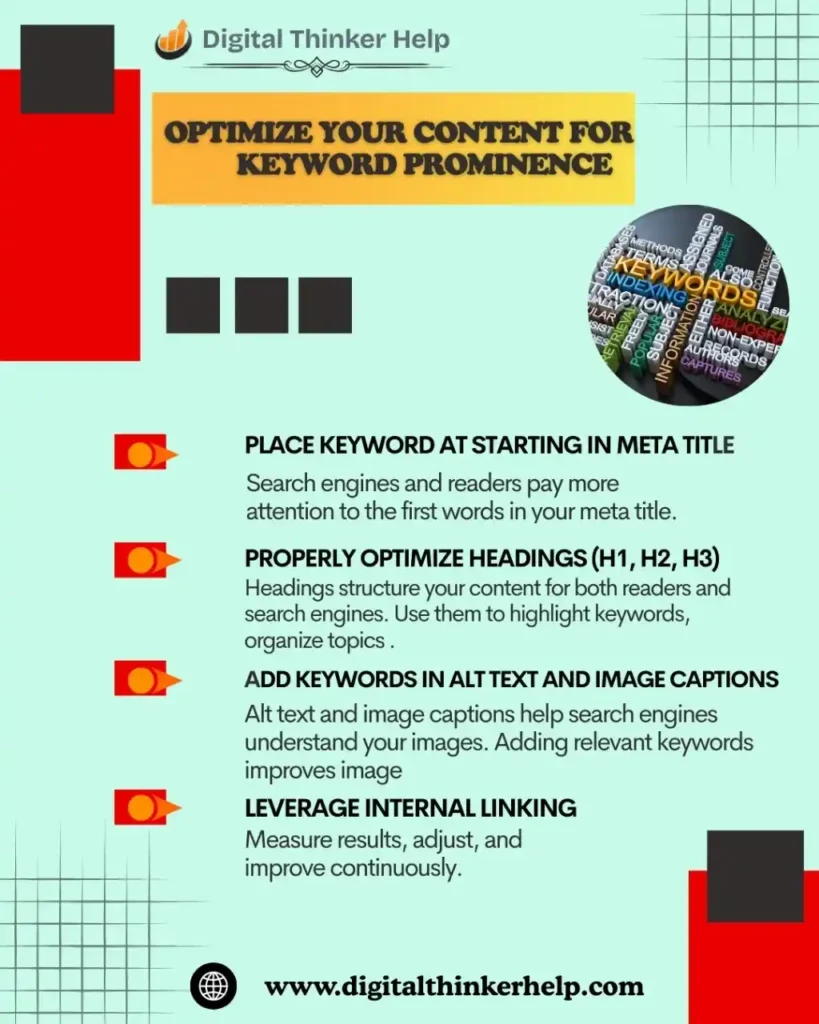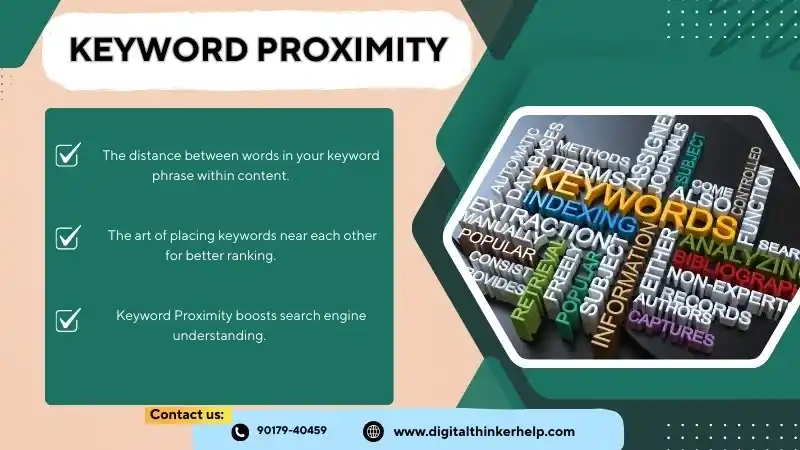Keywords are most important elements for creating online content. They form the strategy to reach SEO goals. Have you ever noticed why some websites show up at the top of search results and others do not? One key reason is keyword proximity, which means how close your main keywords are to each other in your content.
There are several ways to research and use keywords in online content. For example, keyword density, long-tail keywords, latent semantic indexing keywords, and keyword proximity.

From this article, our team will explain what keyword proximity means and provide helpful details about this approaches.
What is Keyword Proximity in SEO?
Keyword proximity is about how do you close the words in your chosen keyword phrase are to each other. This is important because most keywords you target will have more than one word. Single-word keywords are usually very competitive, but longer keywords can work really well.
Also Read: Keyword Density in SEO – And Why Does Matters It in SEO?
When you focus on a phrase, try to keep the words in that phrase close to each other. This proximity can show search engines and users that the page is likely important for what they are looking for.
Consider the keyword “used amazing magazines.” A page that says “There used amazing magazines” is probably more useful for someone searching than a page that says “Huge Selection of amazing magazines and Used Books.”
Why is Keyword Proximity Important?
Importance for Search Engines: When keywords that people usually search for are found close together in your content, search engines may view your page as more relevant to the search, which could boost your rankings.
Improves User Experience: Grouping related terms and ideas together makes the content easier to read and understand.
Understanding Context: Having related keywords close together helps make the meaning clearer. For example, placing “SaaS” and “subscription model” next to each other gives a better understanding than if they are spread out in the text.
Types of Keyword Proximity
- Proximity in SEO (Low Proximity)
Low proximity in SEO means that the keywords or phrases you want to rank for in your content are not close together. For example, if you’re using the keywords ‘organic’ and ‘coffee beans’, a low proximity example could be: ‘We focus on organic products. We offer fresh vegetables, fruits, and grains. Plus, for coffee lovers, we have high-quality coffee beans.’
Also Read: Keyword Stuffing in SEO & How to Avoid and Check it?
Although the text includes the right keywords, putting them too far apart may reduce their effectiveness for searches like ‘organic coffee beans.’ Low proximity apart isn’t always bad; sometimes it can help with how the content reads. But for SEO, it might not work well for ranking certain related search terms.
- Average Proximity
Average proximity means a balance between low and high keyword closeness. Here, the target words are near each other but not right next to each other. For example, average proximity could be: “We sell organic products, like fresh vegetables and coffee beans, great for those who enjoy a natural flavor.”
In this case, the keyword ‘organic’ and ‘coffee beans’ are placed closer together than in the low proximity example. This makes the content more likely to match related search queries. Average proximity usually finds a good balance between being easy to read and good for SEO.
- Close Proximity (High Proximity)
High proximity in SEO means putting important words close proximity together, preferably next to each other. For example, with the keyword “organic coffee beans,” keyword might say: “Our organic coffee beans come from eco-friendly farms.”
In this case, the keywords are close together, making them very relevant for the search term. High proximity is good for SEO when you want to rank for specific word pairs. However, it’s important to keep the content natural and easy to read. If you use keywords too much, it can look like keyword stuffing, which search engines may punish.
Keyword Proximity Vs. Keyword Prominence
Keyword prominence means how noticeable or important keywords are on a website, such as where they are in titles, headings, first paragraphs, or Meta tags. Keywords are seen as more important when they are placed at the start of these elements, since search engines often pay more attention to the beginning of content.

Using keyword proximity well can help show the importance of keywords. Placing related words in important spots, like at the start of content, makes them more visible and relevant. Also, highlighting keywords in key parts of a page helps search engines understand their meaning and relevance.
Optimize Content for Keyword Prominence
Place Keyword at Starting in Meta Title: Make sure your main keyword is at the start of your Meta title. For instance, if your keyword is ‘best coffee in Seattle,’ your title should be ‘Best Coffee in Seattle: A Local’s Guide’ instead of placing the keyword at the end.
Also Read: What are Backlinks in SEO? How to Create Them
Apply Keywords in the First Introduction Paragraph: Make sure your main keyword appears within the first 100 words of your webpage. In blog posts or service pages, use the keyword in a way that keeps the text easy to read. For example, if you want to optimize for ‘affordable web design services,’ you can start your content like this: ‘If you’re looking for affordable web design services, you’ve come to the right place.’
Properly Optimize Headings (H1, H2, H3): Put your main keyword in the H1 tag and use secondary keywords in H2 and H3 tags to improve your SEO. Search engines pay close attention to headings to see how relevant a page is to what people search for. Make sure the main keyword is at the beginning of your H1 or at least included in it.
Add Keywords in Alt Text and Image Captions: For pages with a lot of images, add your main keyword in the alt text of the images. This helps search engines know what the Visual content and can improve image search results.
Always Make Focus on User Experience & Readability: It’s important to use keywords well, but don’t overdo it. Google prefers content that is helpful to readers, so focus on making it easy to read and flowing naturally instead of repeating keywords too much.
Leverage Internal Linking: Use anchor text with relevant keywords for internal links. For instance, when linking to a different page on your site, use your keyword in the anchor text, like ‘learn more about affordable web design services.’
Keyword Proximity Examples
Real-life examples can help explain keyword proximity. Let’s look at some examples to show how keyword proximity changes and why it is important for SEO:
Example: Target Keyword – “Digital Marketing Strategies” –
High proximity: “Discover the best digital marketing strategies to expand your business.”
Low proximity: “We make Digital tools to enhance your marketing and help you plan better and strategies.”
In the high proximity example: The keyword here “digital,” “marketing,” and “strategies” are in the same sentence but not together.)
FAQs (Frequently Asked Questions)
What Does Keyword Proximity Mean in SEO?
Keyword proximity is how close two or more keywords are to each other on a webpage, especially in a sentence. The closer (or distance) they are the better proximity. Search engines consider this when deciding how relevant your content is to what the user is searching for.
Does Keyword Proximity Affect Rankings on Google?
Yes, a little. Keyword proximity isn’t the main factor for ranking, but it can help with relevance and context. When used with quality content, a good structure, and proper keyword placement, it can improve SEO results.
What is a Keyword Proximity Checker?
Keyword Proximity Checker refers such tools that used in SEO to measure how close two or more keywords appear to each other in your web content. For examples; SEO Review Tools, CheckSERP, SE Ranking, and more.
What is Prominence in Local SEO?
Prominence in local SEO means how popular or trusted a business is, both on the internet and in real life.
Final Thoughts
As result of this article, keyword Proximity is an important SEO strategy that lets you helping to increase the chances of appearing in relevant search results.
Also Read: Tier 1 Backlinks Drive Real Organic Traffic & How to Create them?
SEO is not just for search engines; it’s for real people too. Use good keyword placement along with useful, high-quality content to succeed in both areas: higher rankings and more engaged users.
